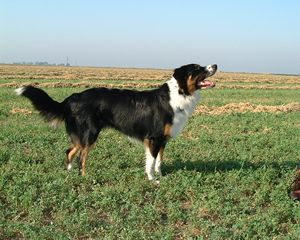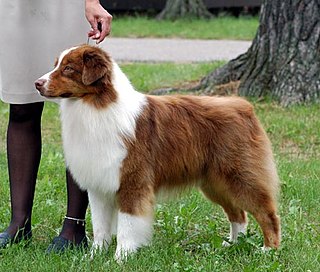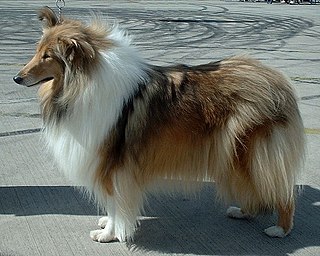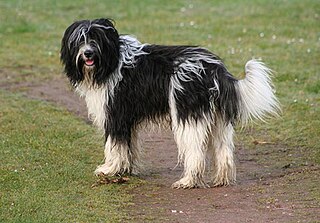
The Australian Kelpie, or simply Kelpie, is an Australian sheep dog successful at mustering and droving with little or no guidance. It is a medium-sized dog and comes in a variety of colours. The Kelpie has been exported throughout the world and is used to muster livestock, primarily sheep, cattle and goats.

The American Kennel Club (AKC) is a registry of purebred dog pedigrees in the United States. In addition to maintaining its pedigree registry, this kennel club also promotes and sanctions events for purebred dogs, including the Westminster Kennel Club Dog Show, an annual event which predates the official forming of the AKC, the National Dog Show and the AKC National Championship. The AKC is not affiliated with the Fédération Cynologique Internationale.

The Border Collie is a working and herding dog breed developed in England's Scottish-bordering county of Northumberland, for herding livestock, especially sheep.

The Shetland Sheepdog, often known as the Sheltie, is a breed of herding dog that originated in the Shetland Islands of Scotland. The original name was Shetland Collie, but this caused controversy among the Rough Collie breeders of the time, so the breed's name was formally changed. This hard-working small dog is intelligent, vocal, excitable and willing to please. They are incredibly loyal to their owners to the point where they are often referred to as "shadows" due to their attachment to family. This breed was formally recognized by The Kennel Club (UK) in 1909.

The English Shepherd is a breed of herding dog from the United States, it is descended from various collies brought to the New World by British settlers.

A herding dog, also known as a stock dog, shepherd dog or working dog, is a type of dog that either has been trained in herding or belongs to breeds that are developed for herding.

Collies form a distinctive type of herding dogs, including many related landraces and standardized breeds. The type originated in Scotland and Northern England. Collies are medium-sized, fairly lightly-built dogs, with pointed snouts. Many types have a distinctive white color over the shoulders. Collies are very active and agile, and most types of collies have a very strong herding instinct. Collie breeds have spread through many parts of the world, and have diversified into many varieties, sometimes mixed with other dog types. Some collie breeds have remained as working dogs for herding cattle, sheep, and other livestock, while others are kept as pets, show dogs or for dog sports, in which they display great agility, stamina and trainability. While the American Kennel Club has a breed they call "collie", in fact collie dogs are a distinctive type of herding dog inclusive of many related landraces and formal breeds. There are usually major distinctions between show dogs and those bred for herding trials or dog sports: the latter typically display great agility, stamina and trainability, and, more importantly, sagacity.

The Pyrenean Shepherd is a medium-small breed of dog native to the Pyrenees mountains in southern France and northern Spain, bred since at least medieval times for herding livestock, especially sheep. It worked as an active herder together with the Great Pyrenees, another breed, which acted as the flock's guardian.

The Australian Shepherd, often known simply as the "Aussie", is a medium-sized breed of dog that was, despite its name, developed on ranches in the United States of America during the 19th century. There is disagreement regarding the exact history of the breed prior to its arrival in the United States, and thus no official consensus on the origin of its name or association with Australia.

The Smooth Collie is a breed of dog developed originally for herding. It is a short-coated version of the Rough Collie of Lassie fame. Some breed organisations consider the smooth-coat and rough-coat dogs to be variations of the same breed.

The Rough Collie is a long-coated dog breed of medium to large size that, in its original form, was a type of collie used and bred for herding sheep in Scotland. Originating in the 1800s, the breed is now well known through the works of author Albert Payson Terhune, beginning with books about Lad, and through Lassie novels, movies, and television shows. Rough Collies generally come in shades of sable and white, blue merle, tri-colored, and white. The breed has a distinctive long tapered snout and tipped ears.

The Belgian Shepherd is a breed of medium- to large-sized herding dogs. It originated in Belgium and is similar to other sheep-herding dogs from that region, including the Dutch Shepherd, the German Shepherd, the Briard, and others. Four types have been identified by various registries as separate breeds or varieties: Groenendael, Laekenois, Tervuren, and Malinois.

The Laekenois is a breed of dog, sometimes classified as a variety of the Belgian Shepherd rather than as a separate breed. "Laekenois" is pronounced LAK-en-wah. The Belgian Laekenois breed was recognized by the American Kennel Club on 1 July 2020. They can be shown in the United States, Great Britain, Canada, Australia, and throughout Europe, along with all three of the closely related breeds that share a heritage with the Laekenois: the Tervuren, the Malinois, and the Groenendael, the last being shown in the U.S. as the Belgian Sheepdog.

The Bergamasco Shepherd is a breed of dog with its origins in the Italian Alps near Bergamo, where it was originally used as a herding dog.

A companion dog is a dog that does not work, providing only companionship as a pet, rather than usefulness by doing specific tasks. Many of the toy dog breeds are used only for the pleasure of their company, not as workers. Any dog can be a companion dog, and many working types such as retrievers are enjoyed primarily for their friendly nature as a family pet, as are mixed breed dogs. The American Kennel Club also offers a Companion dog title for judged dog obedience competitions

The Canaan Dog, also known as the Bedouin Sheepdog and Palestinian Pariah Dog, is a breed of pariah dog from the Middle East. This dog is found in Israel, Jordan, Lebanon, the Sinai peninsula, and these or dogs very similar are found in Egypt, Iraq, and Syria. There are 2,000 to 3,000 Canaan dogs across the world, mostly in Europe and North America.

The Pumi is a medium-small breed of sheep dog from Hungary. They are versatile stock dogs equally adept at gathering, driving and keeping stock under control. They have a long head with semi-erect ears, a whimsical expression, and a tail that forms a circle over the back. The coat is a combination of wavy and curly hair forming curls all over the body.

The Dutch Shepherd is a herding dog of Dutch origin. They were used by shepherds and farmers who needed a versatile dog, with few demands, and a dog that was able to adapt to a harsh and meager existence.

The Russian Toy is a very small breed of dog originally bred in Russia from the English Toy Terrier. There are two types of coats in the breed: smooth coat and long coat. The smooth-coated variety was previously known as the Russian Toy Terrier and long-coated as the Moscow Long Haired Toy Terrier. Both were brought together under the same Russian Toy Terrier name in 1988 and the "Terrier" was dropped from the name when the breed was added in 2006 to the official list of breeds registered with the Fédération Cynologique Internationale and has been registered in the Foundation Stock Service of the American Kennel Club since 2008, allowed to compete in AKC companion events since 2010. The first official breed standard of the two varieties was written in 1966 in Russia.

The Schapendoes or Dutch Sheepdog, is a breed of dog originating in the Netherlands. The Schapendoes was originally a herding dog and general farm dog, but today also participates in dog sports such as agility and flyball.




















